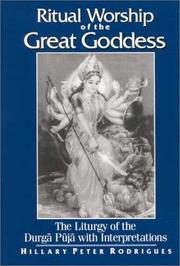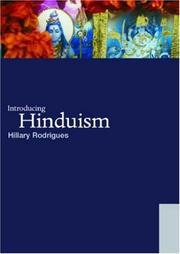| Listing 1 - 9 of 9 |
Sort by
|

ISBN: 0415392683 0415392691 Year: 2006 Publisher: New York Routledge
Abstract | Keywords | Export | Availability | Bookmark
 Loading...
Loading...Choose an application
- Reference Manager
- EndNote
- RefWorks (Direct export to RefWorks)
'Hinduism' describes the array of beliefs and practices of the majority of the people of South Asia, particularly those of India and Nepal. Hinduism is the ideal starting point for students wishing to undertake a comprehensive study of this fascinating religion. This lively introduction explores the complexities of Hinduism, including its social structures, especially its caste system, its rituals and many scriptures, its vast mythology and varieties of deities and its religious philosophies. Hillary Rodrigues, an experienced teacher of the Hindu tradition, emphasizes the importance of Hindu rituals and practice, subjects of particular interest in contemporary scholarship. Illustrated throughout, the book also includes a glossary and a list of further reading.
Hinduism --- -294.5 --- Religions --- Brahmanism --- Hindoeïsme:--verder in te delen zoals 291.1/.8 --- 294.5 --- Vedic religion --- karma --- cosmology --- social organization --- social values --- Dharma --- individuality --- the Sanskrit language --- Indian philosophical schools --- the Epics --- Itihasa --- the Bhagavad Gita --- bhakti --- theistic sects --- deities --- Puranic mythology --- art --- worship rituals --- Vedanta --- tantra --- Hinduism and the West

ISBN: 0791488446 1417506806 9781417506804 0791454002 9780791454008 0791453995 9780791453995 9780791488447 0791453995 9780791453995 Year: 2003 Publisher: Albany, NY State University of New York Press
Abstract | Keywords | Export | Availability | Bookmark
 Loading...
Loading...Choose an application
- Reference Manager
- EndNote
- RefWorks (Direct export to RefWorks)
During a nine-day period every autumn, Hindus in India and throughout the world worship the Great Goddess, Durgā--the formidable deity who is loved like a mother. One of the most dramatic and popular of these celebrations is the Durgā Pūjā, a rite noted for its visual pageantry, ritual complexity, and communal participation. In this book, Hillary Peter Rodrigues describes the Bengali style of Durgā Pūjā practiced in the sacred city of Banaras from beginning to end. A romanization of the Sanskrit litany is included along with an English translation.In addition to the liturgical description, Rodrigues provides information on the rite's component elements and mythic aspects. There are interpretive sections on puja, the Great Goddess, women's roles in the ritual, and the socio-cultural functions of the ritual. Rodrigues maintains that the Durgā Pūjā is a rite of cosmic rejuvenation, of empowerment at both the personal and social levels, and a rite that orchestrates manifestations of the feminine, both Divine and human.
Durgā-pūjā (Hindu festival) --- Fasts and feasts --- Hinduism --- Durgā --- Cult. --- Durgā (Hindu deity) --- Durga (Hindu deity) --- Durga-puja (Hindu festival)
Book
ISBN: 9780415468473 9780415468480 9780203810286 9781136680922 9781136680960 9781136680977 0415468477 0203810287 0415468485 Year: 2011 Publisher: London: Routledge,
Abstract | Keywords | Export | Availability | Bookmark
 Loading...
Loading...Choose an application
- Reference Manager
- EndNote
- RefWorks (Direct export to RefWorks)
Hinduism. --- Hinduism --- Customs and practices.
Book
Year: 2006 Publisher: London: Routledge,
Abstract | Keywords | Export | Availability | Bookmark
 Loading...
Loading...Choose an application
- Reference Manager
- EndNote
- RefWorks (Direct export to RefWorks)
Introducing Hinduism is the ideal starting point for students wishing to undertake a comprehensive study of this fascinating religion. This lively introduction explores the complexities of Hinduism, including its social structures, especially its caste system, its rituals and many scriptures, its vast mythology and varieties of deities, and its religious philosophies. Hillary Rodrigues, an experienced teacher of the Hindu tradition, emphasises the importance of Hindu rituals and practice, subjects of particular interest in contemporary scholarship. Illustrated throughout, the book also includes text boxes, summary charts, a glossary and a list of further reading to aid students' understanding and revision.

ISBN: 9780415392693 Year: 2006 Publisher: New York, N.Y. Routledge
Abstract | Keywords | Export | Availability | Bookmark
 Loading...
Loading...Choose an application
- Reference Manager
- EndNote
- RefWorks (Direct export to RefWorks)
Book
ISBN: 9781540963642 9781540966131 9781493438303 9781493438297 Year: 2022 Publisher: Grand Rapids, Michigan Baker Academic
Abstract | Keywords | Export | Availability | Bookmark
 Loading...
Loading...Choose an application
- Reference Manager
- EndNote
- RefWorks (Direct export to RefWorks)
"This masterful survey of world religions, now revised throughout, presents a clear and concise portrait of the history, beliefs, and practices of eastern and western religions"--
Book
ISBN: 1438470711 9781438470719 9781438470696 143847069X Year: 2018 Publisher: Albany, New York : State University of New York,
Abstract | Keywords | Export | Availability | Bookmark
 Loading...
Loading...Choose an application
- Reference Manager
- EndNote
- RefWorks (Direct export to RefWorks)
Nine Nights of the Goddess explores the festival of Navarātri—alternatively called Navarātra, Mahānavamī, Durgā Pūjā, Dasarā, and/or Dassain—which lasts for nine nights and ends with a celebration called Vijayadaśamī, or "the tenth (day) of victory." Celebrated in both massive public venues and in small, private domestic spaces, Navarātri is one of the most important and ubiquitous festivals in South Asia and wherever South Asians have settled. These festivals share many elements, including the goddess, royal power, the killing of demons, and the worship of young girls and married women, but their interpretation and performance vary widely. This interdisciplinary collection of essays investigates Navarātri in its many manifestations and across historical periods, including celebrations in West Bengal, Odisha, Karnataka, Maharashtra, Tamil Nadu, Uttar Pradesh, and Nepal. Collectively, the essays consider the role of the festival's contextual specificity and continental ubiquity as a central component for understanding South Asian religious life, as well as how it shapes and is shaped by political patronage, economic development, and social status.
Durgā-pūjā (Hindu festival) --- Fasts and feasts --- Hinduism. --- Hinduism --- Durg --- Durgā
Book
ISBN: 0415408881 041540889X 9786611753535 1134132131 128175353X 0203891724 9780415408882 9780415408899 Year: 2008 Publisher: New York: Routledge,
Abstract | Keywords | Export | Availability | Bookmark
 Loading...
Loading...Choose an application
- Reference Manager
- EndNote
- RefWorks (Direct export to RefWorks)
Religion. --- the study of religion --- religious education --- defining religion --- traditional perspectives in religious study --- perspectives in religious consciousness --- perspectives in religious perception --- perspectives in religious phenomenology --- religious psychology --- anthropology --- sociology --- politics --- economy --- gender issues
Book
ISBN: 1438470703 9781438470702 Year: 2018 Publisher: New York: State university of New York press,
Abstract | Keywords | Export | Availability | Bookmark
 Loading...
Loading...Choose an application
- Reference Manager
- EndNote
- RefWorks (Direct export to RefWorks)
Nine Nights of the Goddess explores the festival of Navarātri--alternatively called Navarātra, Mahānavamī, Durgā Pūjā, Dasarā, and/or Dassain--which lasts for nine nights and ends with a celebration called Vijayadaśamī, or "the tenth (day) of victory." Celebrated in both massive public venues and in small, private domestic spaces, Navarātri is one of the most important and ubiquitous festivals in South Asia and wherever South Asians have settled. These festivals share many elements, including the goddess, royal power, the killing of demons, and the worship of young girls and married women, but their interpretation and performance vary widely. This interdisciplinary collection of essays investigates Navarātri in its many manifestations and across historical periods, including celebrations in West Bengal, Odisha, Karnataka, Maharashtra, Tamil Nadu, Uttar Pradesh, and Nepal. Collectively, the essays consider the role of the festival's contextual specificity and continental ubiquity as a central component for understanding South Asian religious life, as well as how it shapes and is shaped by political patronage, economic development, and social status.
| Listing 1 - 9 of 9 |
Sort by
|

 Search
Search Feedback
Feedback About UniCat
About UniCat  Help
Help News
News